by Marjorie Moore | Dec 2, 2013
On November 1-2, 2013, the Northwest District Agriculture and Family and Consumer Sciences (FCS) Agents Program Implementation Teams collaborated to offer classes during the annual Beekeeping Field Day and Tradeshow held in Chipley, FL.
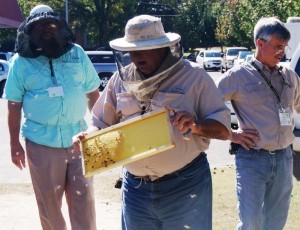
Attendees learn about bee hive maintenance.
This third-annual event was part of the Florida State Beekeepers Association yearly conference and had a total of 196 attendees for the entire three-day event. State Representative Marti Coley and State Senator Greg Evers were keynote speakers at the Bee Conference.
Approximately 163 individuals attended the entire Saturday Beekeeping Field Day and Trade Show, with 114 attending the FCS honey program. Participants rotated among three 35-minute classes – What’s the Buzz about Honey?, Splitting Beehives, and Products of the Hives.
Noted scientist Dr. Jamie Ellis of the University of Florida IFAS Honey Bee Research and Extension Lab presented a class on the state of the beekeeping industry and how Extension works with beekeepers to enhance the success of their honey production and pollination operations.
The FCS Agents presented information on sugar vs. honey, nutrition facts, diabetes and honey, foodborne illnesses, and types of honey. A honey factsheet and recipe cards were developed and distributed. Participants sampled recipes made with honey, including pumpkin bread, honey lemonade, and a honey-glazed snack mix. One batch of the pumpkin bread was made with honey and one batch with sugar to demonstrate the different properties of these two sweeteners.
There was a panel of experts discussing scouting bee hives for insect and disease problems. Also, attendees participated in hands-on hive splitting and hive smoker lighting demonstrations taught by bee inspectors from the Florida Department of Agriculture and Consumer Services.
For more information on honey or beekeeping, please contact your local UF/IFAS Extension Office.
Source: Dr. Marjorie Moore, Family & Consumer Sciences Agent, Bay County, and Matthew Orwat, Horticulture Agent, Washington County.
by Judy Corbus | Nov 26, 2013
Normal
0
false
false
false
EN-US
X-NONE
X-NONE
/* Style Definitions */
table.MsoNormalTable
{mso-style-name:”Table Normal”;
mso-tstyle-rowband-size:0;
mso-tstyle-colband-size:0;
mso-style-noshow:yes;
mso-style-priority:99;
mso-style-parent:””;
mso-padding-alt:0in 5.4pt 0in 5.4pt;
mso-para-margin-top:0in;
mso-para-margin-right:0in;
mso-para-margin-bottom:8.0pt;
mso-para-margin-left:0in;
line-height:107%;
mso-pagination:widow-orphan;
font-size:11.0pt;
font-family:”Calibri”,”sans-serif”;
mso-ascii-font-family:Calibri;
mso-ascii-theme-font:minor-latin;
mso-hansi-font-family:Calibri;
mso-hansi-theme-font:minor-latin;}
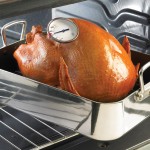 The highlight of many Thanksgiving meals is the turkey –juicy, golden brown, and delicious! Before and after it reaches the table, however, follow these steps to reduce your guests’ risk of foodborne illness.
The highlight of many Thanksgiving meals is the turkey –juicy, golden brown, and delicious! Before and after it reaches the table, however, follow these steps to reduce your guests’ risk of foodborne illness.
Thaw the turkey safely:
- In the refrigerator at 40oF or below– allow 24 hours for every 5 pounds. Place the turkey in a container to prevent the juices from dripping on other foods. Cook within 1-2 days.
- In cold water – submerge the turkey in a leak-proof plastic bag in cold water. Change the water every 30 minutes until the turkey is thawed; allow 30 minutes per pound. Cook turkey immediately after it is thawed.
- In the microwave oven – check your owner’s manual for specific instructions for defrosting a turkey. Plan to cook it immediately after thawing because some areas of the food may become warm and begin to cook during microwaving. Holding partially cooked food is not recommended because any bacteria present would not have been destroyed.
For roast turkey, set the oven temperature no lower than 325°F. For optimum safety, cook stuffing in a casserole. If stuffing your turkey, mix ingredients just before stuffing it; stuff loosely. Additional time is required for the turkey and stuffing to reach a safe minimum internal temperature.
APPROXIMATE COOKING TIMES
(325°F oven temperature)
UNSTUFFED (time in hours)
- 4 to 6 lb. breast — 1 1/2 to 2 1/4
- 6 to 8 lb. breast — 2 1/4 to 3 1/4
- 8 to 12 lbs. — 2 3/4 to 3
- 12 to 14 lbs. — 3 to 3 3/4
- 14 to 18 lbs. — 3 3/4 to 4 1/4
- 18 to 20 lbs. — 4 1/4 to 4 1/2
- 20 to 24 lbs. — 4 1/2 to 5
STUFFED (time in hours)
- 8 to 12 lbs. — 3 to 3 1/2
- 12 to 14 lbs. — 3 1/2 to 4
- 14 to 18 lbs. — 4 to 4 1/4
- 18 to 20 lbs. — 4 1/4 to 4 3/4
- 20 to 24 lbs. — 4 3/4 to 5 1/4
Use a food thermometer to ensure your turkey is safe. Insert thermometer in the innermost part of the thigh, wing, and the thickest part of the breast. The turkey is safe at 165°F. Let the bird stand 20 minutes before removing stuffing and carving.
After the big meal, perishable foods should not be left out of the refrigerator for more than 2 hours. Remove all stuffing from the turkey cavity immediately and refrigerate. Cut turkey into smaller pieces and refrigerate. Slice breast meat; legs and wings may be left whole. Refrigerate potatoes, gravy, and vegetables in shallow containers.
Refrigerator-stored cooked turkey and cooked dishes and gravy should be eaten within 3 to 4 days. Reheat leftovers thoroughly to 165°F or until hot and steaming; bring gravy to a rolling boil. In the microwave oven, cover food and rotate dish so it heats evenly.
For longer-term storage, freeze food in airtight freezer containers or bags and use within 4 to 6 months for best quality.
Questions on Thanksgiving Day?
Ask Karen, the virtual food safety representative, is available 24/7 at AskKaren.gov. Weekdays between 10 a.m. and 4 p.m. ET, the USDA Meat and Poultry Hotline is available at 1-888-MPHotline (1-888-674-6854). On Thanksgiving Day, the Hotline will be open from 8:00 am to 2:00 pm Eastern Time.
Happy Thanksgiving!
Source: USDA Food Safety and Inspection Service, www.fsis.usda.gov.
by Marjorie Moore | Nov 5, 2013
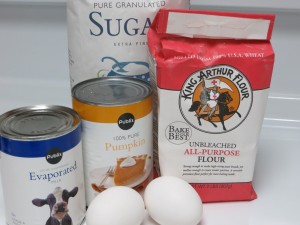
Store homemade pumpkin pies in the refrigerator.
To refrigerate pumpkin pies or not to refrigerate? That is the question. You have seen pumpkin pies in the bakery section of supermarkets not refrigerated and you wonder if you can do the same at home. Unfortunately, homemade pumpkin pies need special care to prevent foodborne illness. Pumpkin pies are a custard-style pie made by using potentially hazardous foods such as eggs and milk. Food temperature controls are especially important with foods classified as potentially hazardous.
Pumpkin pies also have a high moisture and protein content. They must be kept at a refrigerated temperature of 41° F or cooler. If the pies are left out of the refrigerator for more than 2 hours, bacteria grows more rapidly and can cause a foodborne illness.
When cooking, make sure to test your pies for doneness by inserting a clean knife in the center. The knife should come out clean. Remove the pies from the oven and allow them to cool at room temperature for about 30 minutes. After they have cooled, cover and refrigerate to keep them cold.
So, why are pumpkin pies displayed at room temperature at the supermarket? These pies are formulated with shelf-stable ingredients, such as preservatives, that prevent harmful bacteria from growing. Commercial pies must be properly labeled, “approved by the Food and Drug Administration”. They will carry the letters “RT”, which means they meet the guidelines required for display at room temperature. The label will also give a “sell by” or “use by” date. Even these pies should be refrigerated for storage at home especially after they have been cut.
Additional pie safety tips include making sure you purchase clean, refrigerated and uncracked eggs. Keep hands clean by washing them with warm water and soap before handling ingredients. Also, wash utensils, equipment and work surface area with hot soapy water before and after contact with eggs. Never leave milk or eggs out of the refrigerator for more than two hours.
Enjoy those traditional holiday feasts, but keep them safe!
by Dorothy C. Lee | Jul 17, 2013
 “It must be something I ate” often is the explanation people give for a bout of home-grown “Montezuma’s Revenge” or some other unwelcome gastrointestinal upset.
“It must be something I ate” often is the explanation people give for a bout of home-grown “Montezuma’s Revenge” or some other unwelcome gastrointestinal upset.
Despite the fact that America’s food supply is the safest in the world, the unappetizing truth is that what we eat can very well be the vehicle for food-borne illnesses. It is estimated that 76 million cases of food-borne illness occur in the United States every year.
The Food and Drug Administration has given high priority to combating microbial contamination of the food supply but part of the responsibility for preventing food-borne illness lies with the consumer. It is estimated that 35 to 40% of food-borne illness in the United States results from unsafe handling of food at home.
The prime causes of foodborne illness are a collection of bacteria with tongue-twisting names. These organisms can become unwelcome guests at potlucks, picnics, and the dinner table.
They are in a wide range of foods, including meat, eggs, milk and dairy products, coconut, chocolate, seafood, and even water.
Careless food handling sets the stage for the growth of disease-causing organisms. For example, hot or cold foods left standing too long at room temperature provide an ideal environment for bacteria to grow. Improper cooking also plays a role in foodborne illness.
Foods may be cross-contaminated when cutting boards and kitchen tools that have been used to prepare a contaminated food, such as raw chicken, are not cleaned before being used for another food, such as vegetables.
Symptoms
Common symptoms of food-borne illness include diarrhea, abdominal cramping, fever, and vomiting. However, symptoms will vary according to the type of bacteria and the amount of contaminants eaten. For most healthy people, food-borne illnesses are neither long-lasting nor life-threatening. However, they can be severe in the very young, the very old, and those whose immune systems are suppressed.
Prevention Tips
The idea that the food on the dinner table can make someone sick may be disturbing, but there are many steps you can take to protect your family and dinner guests. It is just a matter of following basic rules of food safety.
Prevention of food poisoning starts with your trip to the supermarket. Pick up your canned and packaged foods first. Don’t purchase food in cans that are bulging or dented, or in jars that are cracked. Look for expiration dates on the labels. Likewise, check the “use by” or “sell by” date on dairy products such as cottage cheese, cream cheese, yogurt, and sour cream. Pick the ones that will stay fresh longest in your refrigerator.
When choosing eggs, open the carton and make sure that none are cracked or leaking.
Place frozen foods and perishables such as meat, poultry, and fish in your cart last. Always put these products in separate plastic bags so that drippings don’t contaminate other foods in your shopping cart. Bag cold and frozen foods together, and if it will take more than an hour to get your groceries home, take along an ice chest to keep frozen and perishable foods cold.
Safe Storage
Be sure to refrigerate or freeze perishables as soon as you return from the grocery store. Refrigerator temperature should be 40°F or below and the freezer should be 0°F or below.
For foods that can be stored at room temperature, some precautions will ensure they remain safe.
Store potatoes in a cool dry place—not under the sink or in the refrigerator. Don’t store foods near household cleaning products and chemicals. When you are putting canned food items away, store the older canned items to the front and canned items with the longest-out dates of use in the back row so you’ll be sure to use the older ones first.
Keep It Clean
The first rule of safe food preparation is to keep everything clean. This rule applies to the areas where food is prepared and, most importantly, to the cook. Wash hands thoroughly before starting to prepare a meal and always after handling raw meat and poultry. Keep the work area clean. Wash fruits and vegetables thoroughly. Do not put cooked meat on an unwashed platter that has held raw meat.
The second rule of safe food preparation is keep hot foods hot and cold foods cold.
After the meal, leftovers should be refrigerated as soon as possible.
Here are a few more tips to keep your favorite dishes safe:
- Don’t thaw meat and other frozen foods at room temperature.
- Thaw in the refrigerator or microwave.
- Never taste food that looks or smells spoiled.
All these dos and don’ts may seem overwhelming, but remember: if you want to stay healthy, the old saying, “rules are made to be broken,” does not apply to food safety!
For further information regarding food safety and other related topics, go to the University of Florida’s Solutions for Your Life website: http://www.solutionsforyourlife.com.
Reference: Safe Food Handling Fact Sheets, United States Department of Agriculture, Food Safety and Inspection Service
by Amy Mullins, PhD, RDN | Jun 25, 2013
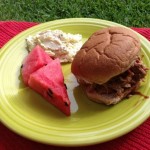
Keep hot foods hot and cold foods cold to reduce the risk of foodborne illness, especially in hot weather.
It’s time for all the fun things that summer brings, like picnics, potlucks, and outdoor gatherings. These are ways we all enjoy celebrating the summer sunshine with friends and family. As things heat up outside, don’t forget the basic rules of food safety to protect yourself and others from foodborne illness.
When transporting, preparing, and serving food outdoors, there are many critical things to consider. First, keep your hands clean. If soap and running water are not available, be prepared with disposable antibacterial wet wipes and hand sanitizer. Use it often and keep it available for everyone at your event.
Be sure to use an insulated cooler with plenty of frozen gel packs and ice for all foods that require refrigeration. Perishable foods, such as potato salads, burgers, hot dogs, chicken, and cheese, should be stored at 40 degrees or less to prevent the growth of harmful bacteria. Pack your cooler accordingly to prevent cross-contamination, securely wrapping and separating raw and ready-to-eat foods, putting raw foods on the bottom. Consider using a separate cooler for juice boxes, soda cans, and water bottles. This will help protect food items from the heat when guests are frequently opening and closing the cooler for drinks.
Cold foods should be kept in the cooler as long as possible before being taken out to serve. Once outside of the cooler, these foods should not set out any longer than 2 hours. If it is really warm (over 90 degrees), one hour should be the limit. Foods that are in the Danger Zone, which is in the range of 40-140 degrees F, for more than this length of time, will start to grow dangerous levels of bacteria. It’s a good idea to serve foods such as potato salad, cut fruit and vegetables, as well as dips and cheeses, in shallow dishes directly in contact with ice. This will help suppress the bacterial growth while it is out of the cooler.
Grilled meats and other hot foods should be kept at a minimum of 140 degrees until served. If prepared prior to the outdoor gathering, wrap foods in foil to retain heat and use a separate insulated cooler just for hot foods. These foods also should not sit out for more than one to two hours. Consider using Sterno cans to keep food hot in covered aluminum pans or chafing dishes. Always use a food thermometer to be sure meats are cooked to the proper minimum temperature (160 degrees F for burgers and 165 degrees F for chicken) before storing or serving. For additional information, check out www.fda.gov or www.foodsafety.gov.
by Marjorie Moore | Jun 21, 2013
Kids out of school, going to the beach, barbequing in our back yards, these are just a few signs that summer is really here! And with that comes some extremely hot days, especially here in Florida.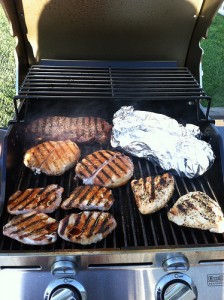
As you welcome summer, we want to remind you that safe grilling practices are the key to making your cookout a big hit with your family and guests.
Foodborne illness, often called “food poisoning”, comes from food you eat. It’s caused by ingesting pathogenic bacteria. You can’t see, smell, or taste these pathogens. What’s more, they cause a variety of foodborne illnesses and can make you really sick.
E. coli 0157:H7 and Salmonella are examples of two pathogens that are commonly associated with foodborne illness. E. coli 0157:H7 is commonly associated with ground beef and Salmonella with poultry but they are not limited to these two foods.
To reduce your chances of a foodborne illness when grilling out, keep your surfaces and equipment clean. Keep hands clean by washing them with soap and warm water for 20 seconds before and after handling food.
Keep food in the refrigerator until ready to use. Your refrigerator temperature should be 40°F or colder. These temperatures slows the growth of bacteria.
Always keep raw meats and poultry separate from cooked foods and foods to be eaten raw such as fruits and vegetables. Juices from raw meats can contaminate these foods. When grilling meat and poultry, they tend to cook very fast and may look done on the outside. Always use a thermometer to be sure the food has reached a safe, minimum, internal temperature. Insert the thermometer in the thickest part of the food away from the bone and fat toward the end of the cooking process.
If cooking ground beef, cook patties to a temperature of 160°F. Do not rely on color to test for doneness. Use a thermometer! Cook steaks to a temperature of 145°F to 170°F. The temperature for steaks depends on whether you want it medium rare, medium or well done. Ground beef is cooked to a higher temperature because bacteria that may have been on the outside of the meat is now mixed throughout the meat. All poultry must be cooked to an internal temperature of 165°F. Once meat or poultry are cooked, never put it on the same dish that your raw meat was on unless the dish has been washed with soap and water.
Always marinade foods in the refrigerator. Never use marinade or sauce that has come in contact with the raw product. Brush or sprinkle sauces or spices on the surface of cooked burgers. Adding them to the meat may make it look brown before it is done.
Do not keep grilled food out longer than two hours or one hour if the temperature is above 90°F! Avoid the “danger zone” — keep food hot after cooking (140°F or above) and cold food cold (40°F or less).
If you would like to contact Dr. Moore for more information, you can reach her at the UF/IFAS Bay Extension Office at 784-6105.






